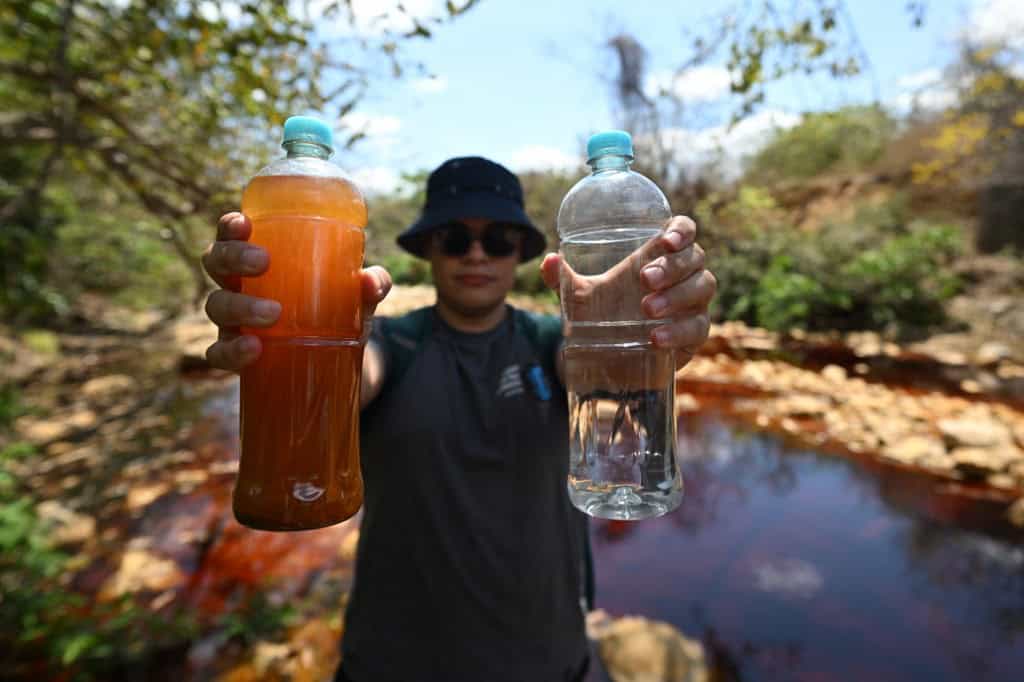The San Sebastián River no longer has fish. The contaminated water it receives from an old gold mine killed them all. Now that mining has once again become legal in El Salvador, the fear is that this phenomenon will be reproduced in other parts of the country. The ban on metal mining, which had been in effect since 2017, was repealed in December at the request of President Nayib Bukele.
According to the president, a study whose authorship he did not reveal assures that the country has gold deposits valued at 131 billion dollars, equivalent to “380% of GDP.” Their extraction would boost the Salvadoran economy, which has experienced slow growth since dollarization in 2001. But environmentalists doubt these figures and claim that mining will bring more harm than good. And they cite the case of the contaminated San Sebastián River.
In Santa Rosa de Lima, 172 km from the capital, wastewater flows into the river from Cerro San Sebastián, where a gold mine has been inactive since 2006 after being exploited for a century. Community leader Graciela Funes extracts a sample from the river, and in the bottle you can see the copper-colored liquid: “Here are the facts,” she says.
“It is not possible for us to allow this situation […], we are human and we all need this vital liquid [water],” said the 67-year-old woman. Environmentalist Vidalina Morales, who accompanies Funes at the river, suggests “closing ranks” against mining. In 2016, the Office for the Defense of Human Rights indicated in a report that this mine had “severely impacted the quality and availability” of water in this agricultural area of the department of La Unión.
The report, which possibly contributed to Congress outlawing mining a year later, highlighted that the population surrounding the mine “has managed to survive in this critical environment” thanks to “the purchase of water.”
Pending Debt
The San Sebastián mine was considered “the most productive in Central America” during much of the 20th century, explains biologist Cidia Cortés, author of a study on mining, in San Salvador. Between 1904 and 1953, foreign companies extracted at least 32 tons of gold from this mine, but its exploitation “left a legacy of misery, disease, and environmental damage,” according to the same report.
In 1987, the government granted a concession for the mine to the American company Commerce Group but revoked its license in 2006. Today, some artisanal miners still search for gold in its tunnels. “Resolving the environmental and health damage left by mining projects was a pending debt of the State,” Cortés said.
“Today that debt is still outstanding and is getting worse because there will be mining again,” adds the biologist and member of the Association of Environmental Women.
Opportunity for the Country
Environmental defenders fear that mining will contaminate, for example, the Lempa River, which flows through areas of mining potential and supplies water to 70% of the capital’s inhabitants. However, the reintroduction of mining also has supporters.
“The country is facing the opportunity to move towards economic development with mining, and there could be better living conditions for the population,” political analyst Nelson Flores said, rejecting the “apocalyptic scenario that environmentalists paint.”
“Mining has advanced, and there are more modern extraction methods that respect the environment and protect natural resources,” he points out. “It would be absurd to deny the country the possibility of advancing in its economic development,” Flores adds.
Does that Gold Exist?
The president of the NGO Salvadoran Center for Appropriate Technology, Ricardo Navarro, assures that “the amount of gold reserves in El Salvador has been exaggerated.” Moreover, “the concentration of gold in Salvadoran soil is one gram per ton of rock: little gold and much damage,” he explains.
Economist Julia Martínez says that Bukele is interested in the “money that the treasury could obtain,” but “we don’t see a study that explains if that gold actually exists.” “I think [the president] has been duped,” says Martínez, who claims that foreign companies that obtain mining concessions will try to pay “crumbs” in royalties.






